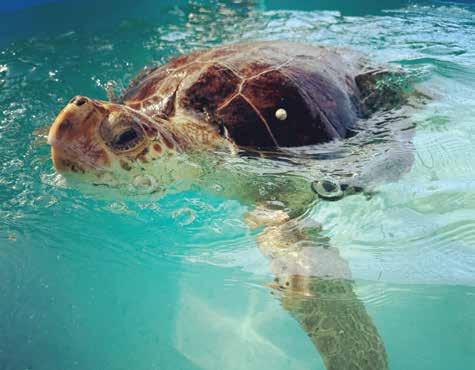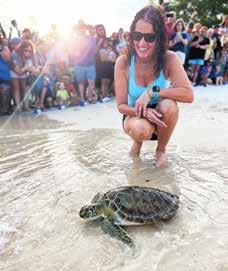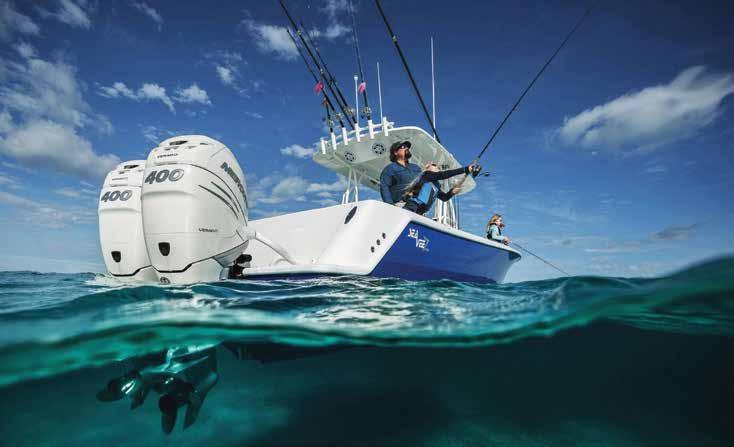
4 minute read
SHARING THE WATER WITH SEA TURTLES
The Florida Keys, with their abundance of sea life and picture-perfect blue-green waters, have an enchanting allure for boating and fishing enthusiasts. Sea turtles have been drawn to this same ecosystem long before recreational sportsmen, but human impacts are causing undeniable problems for these beloved reptiles. Educating yourself on the dangers these impacts pose to sea turtles and making a conscious effort to fish and boat responsibly while enjoying the Keys’ surrounding waters will help to save lives.
The Turtle Hospital, located in Marathon at MM 48.5, has been rescuing, rehabilitating and releasing sea turtles back into the wild for more than 36 years. The hospital is seeing an increased number of sea turtles with boat strikes. With more than 20 documented injuries in the Florida Keys since the beginning of the year, the recent influx happens as turtles make their way through shallow waters to nest. Many of these vessel strikes result in death for the sea turtle.
In addition, the hospital frequently admits sea turtles entangled in fishing gear. Turtles are opportunistic feeders, meaning they will eat just about anything. Unfortunately, a turtle’s digestive tract is unable to break down synthetic material once it is ingested, and very often it will cause an intestinal blockage called an impaction. A turtle has little chance of eliminating the impaction on its own in the wild, and this condition will usually end in starvation. At the Turtle Hospital, impacted turtles are treated with mineral oil, fluids, vitamins and broad-spectrum antibiotics.
Sea turtles are also caught in fishing and buoy lines far too often. Fishing line takes 600 years to biodegrade. So, every single piece of monofilament that has ever entered the ocean is still there, and there is more and more every day. Monofilament fishing line is very difficult to break, so if you fish, or if you see someone else’s discarded line, please dispose of it properly.
Monofilament recycling bins are now located on fishing bridges, beaches and marinas throughout the Florida Keys. If you pick up a piece of fishing line, you will save a life – in its 600-year life span, the odds are good it will get caught on a turtle, shark, dolphin, fish or coral.
All five species of sea turtles found in and around the Florida Keys are classified as endangered or threatened and are afforded corresponding protection under U.S. federal and Florida state laws.
Please help to spread the word about sea turtles and the challenges they face. A little bit of knowledge and a lot of passion will go a long way. Have fun out on the water, and when boating, stay alert and avoid sea turtles.
To report an injured turtle, call the Turtle Hospital’s stranding hotline at 305-481-7669.
Visit the hospital, open every day from 9 a.m. to 6 p.m., to meet sea turtles up close. For more information or to book an educational program, visit turtlehospital.org or call 305-743-2552.




BY ERIN STOVER SICKMEN
I’m going to tell you the best-kept secret of the Keys. The dogs already know, so it seems only fair to tell the humans. What the snowbirds don’t realize, as they flock north in search of temperate climates, is that the locals are preparing for their own magic season. Summer in the Keys is brutal, yes. But with those punishing temperatures come placid water days, perfect for offshore explorations. And as the humans prep boats and pull gear out of the garage for summer adventures, their four-legged friends are looking out the window in anticipation. Dogs know. And those of us with willing canine companions know there’s nothing better than outdoor exploits with our best friends. However, there are a few things to remember as we charge into the season of beach days and boat outings.
Boat Days Are The Best Days
The only thing that improves a day on the sandbar is the addition of a pack of playful dogs. Well, and cold beer. And maybe fried chicken. But really, dogs make the day. Of course, your friend is probably even more excited than you are to hit the not-so-high seas. Not to curb that enthusiasm, but there are some helpful basics that will ensure both dogs and humans have the best day possible.
Safety is paramount when it comes to taking pets on a boat. All dogs, regardless of swimming prowess, should have properly fitted life vests with a handle on their back. A strong current or mouthful of seawater can cause the toughest dog to get in trouble. Vests should be brightly colored and allow for comfortable movement and potty access. Now, let’s consider the reason for the vest – dog overboard! It can happen in a flash as an overzealous yelper barks at the wake or catches sight of a cormorant. Even a tight, fast turn can send a pup flying. The first safety step is to cut the engine. If your dog is further back, turn on the engine so you can get close enough before cutting it again. If possible, call your dog to the vessel and grab the handle on their vest. For bigger breeds, be cautious about jumping in after them, as a panicking animal reacts much like a panicking human and can pull a rescuer under with them. If possible, drop a floating platform or paddleboard in the water until you can grab their vest and get them on board.

Safety is important, but so is comfort. Our waterborne pups should have the same accoutrements as their human counterparts. Dogspecific sunscreen is a good idea, especially for light-colored animals, or those with thin spots of fur. Fresh water is an obvious necessity, but a collapsible dish makes it easier to manage. A soft, dry towel will also be appreciated. Think how great that snuggly hoodie feels on the chilly ride home. Your friend agrees.








